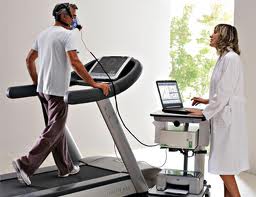|
| |
What is TST ( Treadmill Stress Test )
Main
Article page |
Beauty articles
|
Health page |
Computers|
Diseases |
Education |
Entertainment |
Family
Business |Fitness|
Fruits and Vegetables
|
Jobs |
General |
Personality|
Technology
|
Tourism |
Useful Tips
General Knowledge |
Biography Page|
Heroes & Incredible peoples
|
Inventions
Health Page|
Diseases and Remedies |
Articles|
List of diseases

A treadmill stress test evaluates your heart’s
response to physical activity through the monitoring of your heart rate, blood
pressure, and electrocardiograms while you exercise on a treadmill.
- An echocardiogram is a painless, harmless test that uses
high frequency sound waves (ultrasound) to examine the heart’s anatomy and
function.
- A treadmill stress test evaluates your heart’s response
to physical activity through the monitoring of your heart rate, blood
pressure, and electrocardiograms while you exercise on a treadmill.
- When the two tests are combined, an assessment can be
made of the status of your heart at rest, as well as during and immediately
following stress. This can provide your doctor with information regarding
whether or not you have significant blockages in your heart arteries. Other
information obtained includes an assessment of the pumping function of your
heart and the status of your heart valves.
Common reasons to have a stress echocardiogram
- To determine if coronary artery disease is present and if
further studies and /or treatment are required.
- To evaluate progress following a major cardiac event
(heart attack, heart surgery, etc.).
- To investigate the effort of exercise on heart valve
function.
Preparing for the test
- DO NOT eat or smoke for 3 hours before the test. You may
drink water.
- Do take your usual medications with water, unless
instructed otherwise by your doctor or nurse. Diabetics who use insulin or
glucose lowering agents may need to adjust their dosage. Please check with
your physician if you are not sure.
- Do wear loose fitting clothing that allows easy access to
the chest, and comfortable walking shoes.
The treadmill stress test
- The entire test will take approximately 1 hour, although
you will be walking on the treadmill for approximately 10 minutes of that
time.
- The stress test will be performed in a stress test
laboratory by specially trained medical providers.
- You will be asked to disrobe from the waist up and will
be provided with a gown to wear allowing a small area of your chest to be
exposed.
- Electrodes will be placed on your chest and wires will be
attached to the electrodes so that the electrocardiogram
(ECG) can be monitored continuously during the test.
- In men, limited shaving of the chest may be required to
assure good contact between the skin and the electrodes.
- A blood pressure cuff will be placed on your arm so that
your blood pressure can be measured before, during and after exercise.
- Next you will be asked to lie on an examining table and
the sonographer (a specially trained ultrasound technologist) will obtain
ultrasound pictures of your heart using a small hand-held transducer and
water-soluble gel.
- The lights will be dimmed to reduce glare so that the
sonographer can better see the picture monitor. The pictures obtained
during the ultrasound examination will be recorded on a videotape.
- You will then walk on a treadmill, which is an electrical
walkway that can be raised.
- The speed and incline will increase gradually, such that
you will be walking uphill.
- Your blood pressure will be checked intermittently and
from time to time you will be asked if you are experiencing any symptoms.
- You will be encouraged to exercise for as long as you
can. If you notice chest pain, dizziness, weakness, lightheadedness, or leg
fatigue, say so as soon as any of these symptoms occur.
- Immediately after stopping exercise, you will be helped
quickly back onto the examining table and the sonographer will again take
ultrasound pictures of your heart.
- You may be asked to hold your breath for short periods
during this time so that the best possible pictures can be obtained.
Ideally, the post-stress pictures are obtained within 1 minute of stopping
exercise.
- You will continue to be monitored until your heart rate
and blood pressure returns to pre-exercise levels.
Is it safe?
Stress testing is very safe. The likelihood of a serious
complication (such as a heart attack or death) is less than 1 in 10,000. It is
important to keep in mind that you will be continuously and extensively
monitored throughout the test by experienced personnel and that the test will be
stopped if there is any indication that continuing exercise would be unsafe in
any way. There are no reports of complications related to the use of diagnostic
ultrasound.
When will I receive the results?
Your test will be reviewed and interpreted by a cardiologist
and a report will be provided to you physician who will contact you.
( Courtesy: http://www.cardiosmart.org/
. Read
more )
More information about
Treadmill stress test
Articles:
More...
| |
|



